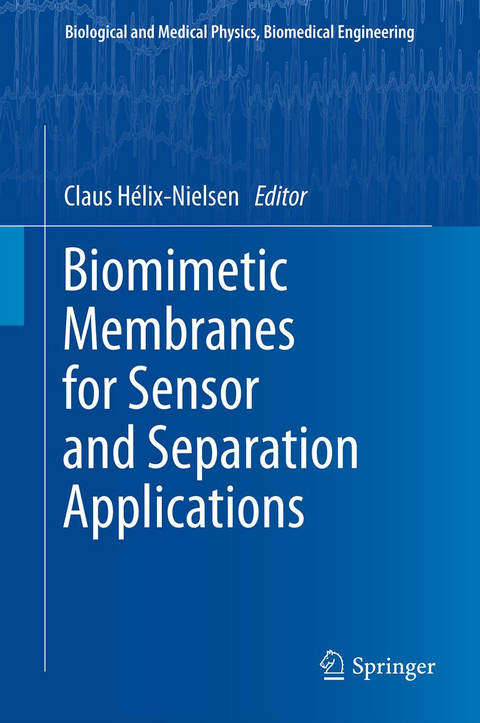
Biomimetic Membranes for Sensor and Separation Applications
Springer (Verlag)
978-94-017-8224-1 (ISBN)
Once reconstituted in its final host biomimetic matrix the protein stability also needs to be maintained and controlled. Beta-barrel proteins exemplified by the E. Coli outer membrane channels or small peptides are inherently more stable than alpha-helical bundle proteins which may require additional stabilizing modifications. The challenges associated with insertion andstabilization of alpha-helical bundle proteins including many carriers and ligand and voltage gated ion (and water) channels will be discussed and exemplified using the aquaporin protein. Many biomimetic membrane applications require that the final device can be used in the macroscopic realm. Thus a biomimetic separation device must have the ability to process hundred of liters of permeate in hours – effectively demanding square-meter size membranes. Scalability is a general issue for all nano-inspired technology developments and will be addressed here in the context biomimetic membrane array fabrication. Finally a robust working biomimetic device based on membrane transport must be encapsulated and protected yet allowing massive transport though the encapsulation material. This challenge will be discussed using microfluidic design strategies as examples of how to use microfluidic systems to create and encapsulate biomimetic membranes. The book provides an overview of what is known in the field, where additional research is needed, and where the field is heading.
The Editor, born in 1964, Lemvig, Denmark, received his PhD in Physics in 1993 from the Technical University of Denmark. After several research positions, among which a postdoctoral fellowship at the Weill Medical College, Cornell University (1995-2000), he became an associate professor at the Technical University of Denmark. Currently he is the Research Director at Aquaporin, Lyngby, Denmark.
1 Sensing Meets Separation: Water Transport Across Biological Membranes Stanley D. Hillyard; 2 Nature Meets Technology: Forward Osmosis Membrane Technology Filicia Wicaksana, Anthony G. Fane, Chuyang Tang, and Rong Wang; 3 Polymer-Based Biomimetic Membranes for Desalination Manish Kumar, Michelle M. Payne, Sean K. Poust, and Julie L. Zilles; 4 Ion-Selective Biomimetic Membranes Henk Miedema; 5 Vesicle Arrays as Model-Membranes and Biochemical Reactor Systems Sune M. Christensen and Dimitrios Stamou; 6 Active Biomimetic Membranes Flemming Cornelius; 7 Passive Transport Across Biomimetic Membranes Karin Stibius, Sania Bäckström, and Claus Hélix-Nielsen; 8 Multi-scale Modeling of Biomimetic Membranes Hans Enggrob, Lars Yde, Mathias Gruber, and Himanshu Khandelia; 9 Regulation of Protein Function by Membrane Elastic Properties Jens A. Lundbæk and Olaf S. Andersen; 10 Large Scale Biomimetic Membrane Arrays Mark Perry, Christian Rein, and Jörg Vogel; 11 Systems for Production of Proteins for Biomimetic Membrane Devices Nicola Altamura and Giuseppe Calamita; 12 Strategies for Integrating Membrane Proteins in Biomembranes Jesper S. Hansen, Inés Plasencia, and Kamila Pszon-Bartosz; 13 Microfl uidic Encapsulation of Biomimetic Membranes Oliver Geschke; Index.
| Reihe/Serie | Biological and Medical Physics, Biomedical Engineering |
|---|---|
| Zusatzinfo | XVI, 292 p. |
| Verlagsort | Dordrecht |
| Sprache | englisch |
| Maße | 155 x 235 mm |
| Themenwelt | Medizin / Pharmazie ► Physiotherapie / Ergotherapie ► Orthopädie |
| Naturwissenschaften ► Biologie ► Biochemie | |
| Naturwissenschaften ► Biologie ► Mikrobiologie / Immunologie | |
| Naturwissenschaften ► Physik / Astronomie ► Angewandte Physik | |
| Technik ► Maschinenbau | |
| Technik ► Medizintechnik | |
| Schlagworte | aquaporin protein • block copolymer building blocks • ion channels • large scale membrane array • membrane encapsulation strategies • microfluidic encapsulation • osmoregulation • voltage-gated ion channels • water and ion channels |
| ISBN-10 | 94-017-8224-5 / 9401782245 |
| ISBN-13 | 978-94-017-8224-1 / 9789401782241 |
| Zustand | Neuware |
| Haben Sie eine Frage zum Produkt? |
aus dem Bereich


